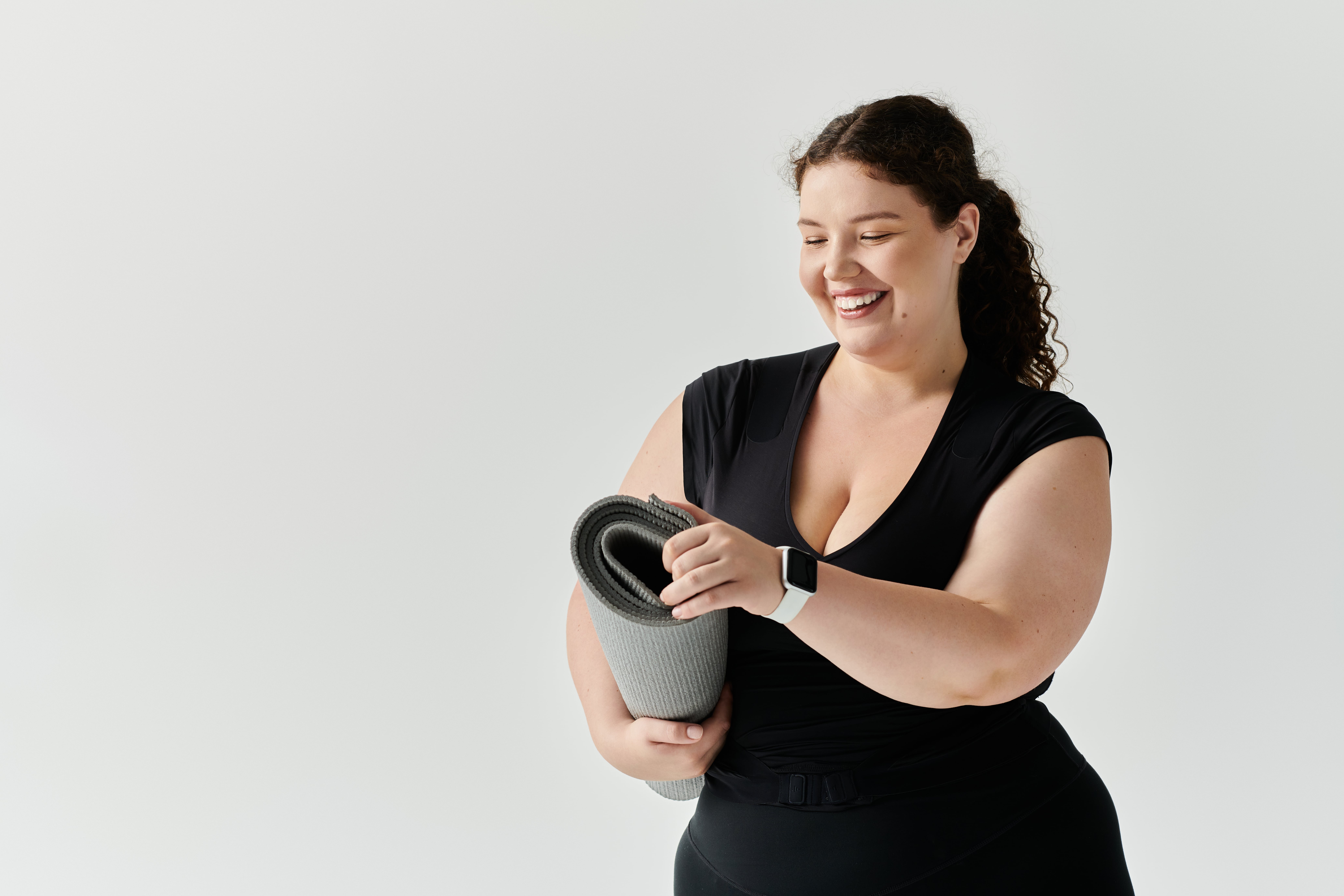Key Takeaways
- Metabolism is the process by which your body breaks down and uses the nutrients from the food you eat.
- Many common beliefs about metabolism are myths that distract from the real factors, like overall calorie balance and sustainable habits.
- Quick fixes like "fat-burning" foods or late-night eating restrictions won’t significantly impact metabolism, but consistent, science-backed habits like quality sleep, regular movement, and nourishing meals impact healthy metabolism long term.
{{mid-cta}}
If you’ve ever felt whiplash from all the mixed messages about metabolism, you’re not imagining it. The wellness industry thrives on confusion. Quick fixes, miracle foods, “metabolism hacks,” most of it is marketing noise designed to make you doubt your body and buy the next product.
Let’s cut through the hype. Metabolism isn’t broken, mysterious, or waiting for the right supplement to unlock it. It’s the biological process that turns food into energy.1 And when you understand how it really works, you stop chasing myths and start making choices that actually support your body.
Here’s what most people (especially women) get wrong about metabolism.
Myth #1: A Slow Metabolism Is to Blame for Weight Gain
When your body starts to feel different (clothes fit tighter, energy dips lower, recovery feels slower), the first instinct is often to blame a “slow metabolism.” It’s an easy scapegoat because it feels invisible, mysterious, and out of your control.
Here’s the reality: for the majority of people, metabolism isn’t the problem. Unless you’re dealing with specific medical conditions like thyroid disorders or other rare metabolic diseases, your metabolism isn’t “broken.”
Your basal metabolic rate (BMR), the energy you burn at rest, comes down mostly to things you don’t control: genetics, sex, age, body size, and muscle mass.2 Muscle plays a huge role here. A body with more lean tissue burns more energy just existing than one with less. That’s why two people of the same weight but with different muscle mass can have very different metabolic outputs.
So if metabolism isn’t the villain, what is? Most often, it’s the balance between what goes in and what goes out. Yes, “calories in versus calories out” may sound overly simplistic, but it’s the lever that moves the most. Energy balance explains why your body changes far more often than a mythical “sluggish metabolism.”
The harder truth: it’s easier to underestimate intake and overestimate output. That 15-minute jog may feel heroic, but it doesn’t erase the extra 500-calorie snack grabbed while multitasking. Habits, stress, sleep, and recovery play bigger roles than most people realize.
Instead of assuming your body has betrayed you, zoom in on what you can influence:
- Daily movement: Are you consistently active outside the gym?
- Recovery: Are you sleeping enough to regulate hunger hormones and repair muscle?
- Nutrition: Are your meals protein-rich, high-fiber, and balanced, or mostly quick carbs that spike and crash your glucose?
Blaming a “slow metabolism” is convenient, but it takes away your power. The truth? Your body isn’t broken; it’s waiting for habits that support it.
Myth #2: Eating Every Few Hours Boosts Your Metabolism

Diet culture loves this one. The advice sounds scientific: “Eat six small meals to keep your metabolism revving like a furnace.” It’s been passed around so often that many people accept it as fact.
Here’s what’s actually happening: your body burns a small amount of energy digesting food, a process called the thermic effect of food (TEF). But whether you split your daily intake into three meals or six, the total energy burned is the same if the calories and macros are identical.
Six meals don’t magically add an extra metabolic boost. They just spread the burnout differently. It’s like cutting one log into six pieces versus keeping it whole; the total firepower doesn’t change.
So where did the myth come from? Likely from the fact that chronic undereating and extreme restriction can lower metabolic rate.3 If you skip meals to the point of depriving your body, your system adapts by conserving energy. Eating regularly protects against that slowdown, but “regular” doesn’t mean eating every two hours.
What does matter is:
- Consistency: Your body likes predictable rhythms, not chaotic feast-and-famine cycles.
- Nourishment: What’s on the plate matters more than when you eat it. Protein, fiber, and healthy fats stabilize glucose and keep hunger balanced far better than a string of low-quality mini meals.
- Personal fit: Some people feel best eating three solid meals. Others prefer smaller, more frequent eating. The “best” approach is the one you can stick with that supports steady energy and glucose stability.
The real danger of the six-meals-a-day myth? It adds stress. Watching the clock, prepping endless snacks, and panicking if you miss a window creates anxiety around food, a stressor that disrupts hormones and metabolism.
Metabolism doesn’t need micromanaging. It needs quality fuel, eaten in a way that works with your life, not against it.
Myth #3: Your Metabolism Is Fixed and Can’t Be Changed
This one’s tricky because it’s half-true. Genetics writes the first draft of your metabolism. Your age, sex, and family background set the baseline, and yes, metabolism naturally slows a bit as you age or lose lean muscle.2
But “fixed”? Not even close. Your metabolism isn’t cemented in place; it’s adaptable. Your daily choices either support it or stress it.2
The most powerful lever? Muscle. Resistance training isn’t just for athletes or bodybuilders; it’s one of the strongest tools for women’s metabolic health. Muscle tissue is metabolically active, which means the more you have, the more energy your body burns all day long, even while you’re sleeping or scrolling on the couch.
But it’s not only about workouts. Metabolism is influenced by:
- Sleep quality: Poor sleep disrupts hormones like leptin and ghrelin, making you hungrier while slowing energy use.
- Nutrition: Protein and fiber not only stabilize glucose but also raise TEF (that small calorie burn from digesting food).
- Stress: High cortisol levels don’t just make you feel on edge; they also drive glucose spikes, fat storage, and metabolic dysfunction.
So no, you can’t magically double your metabolism. But you can train it, feed it, and support it so it works with you instead of against you. That’s not a hack; it’s long-term metabolic power.
Myth #4: Green Tea, Spicy Foods, or “Fat-Burning” Foods Speed Up Metabolism

If only metabolism worked like TikTok says it does. A sprinkle of cayenne, a daily mug of matcha, or a “fat-burning” supplement, and boom: your metabolism’s on fire, right? Wrong.
The truth: foods like green tea, chili peppers, or caffeine may nudge your calorie burn, but we’re talking tiny.5 Maybe an extra 20 to 40 calories a day.5 That’s the equivalent of a few bites of food, not a body transformation.
This myth persists because it sells. It’s easier to market a magic drink than to tell people the less glamorous truth: stable energy, better glucose control, and long-term metabolic health come from daily habits, not ingredients.
That doesn’t mean these foods are useless. Green tea is full of antioxidants. Spicy foods can add flavor and help with satiety. But they’re seasoning, not strategy.
The bigger metabolic wins come from:
- Balancing meals with protein, fat, and fiber to blunt glucose spikes.
- Avoiding overreliance on supplements that overpromise.
- Using food to fuel your body, not fight it.
If you’re relying on hot sauce or tea bags to “torch fat,” you’re chasing sparks when what you really need is a steady fire.
Myth #5: Late-Night Eating Slows Down Metabolism and Causes Fat Gain

This one has haunted women for decades: the idea that your body has a “shut-off” switch after 8 p.m., and anything eaten past that point gets stored as fat. The guilt baked into this myth is powerful, but not supported by science.
Metabolism doesn’t suddenly clock out at night. Your body continues to process and use energy 24/7. What matters most is what you eat, how much you eat overall, and whether your habits are consistent.
But here’s the nuance:
- Insulin sensitivity is higher earlier in the day. Your body tends to handle glucose better in the morning and afternoon than late at night.6
- Late eating often equals poorer choices. After a long day, you’re tired, stressed, and more likely to reach for calorie-dense, low-fiber foods.
- Studies are mixed. Some show that eating more at night is linked to weight gain, while others find no difference once total calories are controlled.7
So is late-night eating automatically bad? No. But it can be a trap if it consistently leads to extra calories or poor food quality.
The real shift is moving from guilt to awareness. Instead of panicking about a bedtime snack, ask: Am I actually hungry? Did I skip a balanced dinner? Am I tired and looking for comfort? Answering those questions is more metabolically powerful than following a fake food curfew.
Why Women Are More Likely to Believe These Myths
If you’ve ever fallen for one of these myths, you’re not alone. And it’s not because women don’t know better; it’s because the wellness industry has trained women to doubt their own bodies.
Social feeds push “fixes” like metabolism teas or hormone-balancing gummies at the exact moment you feel the most vulnerable. Add in biological realities (menstrual cycles, pregnancy, perimenopause, menopause) and you’re left with shifting energy, hunger, and body composition… but no clear answers.
Here’s the unfiltered truth:
- Women have less muscle mass and more body fat than men on average, which means lower resting calorie burn, not because your metabolism is broken.
- Hormones like estrogen and progesterone influence appetite, glucose, and energy use throughout the cycle. These changes are real, but they’re rarely explained.
- With age, muscle naturally declines and metabolism slows, but lifestyle can offset that decline.8
The problem isn’t your metabolism. The problem is the myths and quick fixes that keep women chasing hacks instead of real solutions.
And here’s where data is a game-changer: by watching your glucose in real time, you get to see how your unique body responds to food, stress, sleep, and movement. No guesswork. No gimmicks. Just clarity.
How to Support Metabolic Health: What Actually Works

Supporting your metabolism doesn’t mean hunting down hacks. It means giving your body the inputs it thrives on. Forget the noise; these are the evidence-backed moves that make the biggest difference:
1. Strength Training: Your Metabolic Superpower
Muscle is metabolically active tissue; it burns energy even when you’re not moving. Lifting weights, resistance bands, or bodyweight training helps preserve and build muscle, which supports metabolic rate across every life stage.
- Studies show resistance training improves metabolic rate and body composition in women of all ages.9
- Bonus: it also helps stabilize glucose, making energy more consistent and crashes less likely.
2. Nourishing Nutrition: Food as Fuel, Not Rules
Instead of chasing “fat-burning foods,” focus on balance:
- Protein keeps you fuller, protects muscle, and smooths glucose curves.
- Fiber-rich carbs slow glucose spikes and support gut health.
- Healthy fats balance hormones and keep energy stable.
- Colorful produce adds antioxidants that protect cells and support metabolic function.
With Signos, you see the glucose impact of your meals instantly. No more guessing whether six small meals are “better” than three, or stressing over carbs; you’ll know what fuels your body best.
3. Stress Care: Metabolism’s Hidden Variable
Chronic stress keeps cortisol high, which drives glucose spikes, cravings, and fat storage. Stress management isn’t “nice to have;” it’s core metabolic hygiene.
- Try breathwork, meditation, journaling, or simply walking outside without your phone.
- Even laughter lowers cortisol. Call a friend, watch a show that makes you belly laugh; yes, that counts as metabolic care.
4. Quality Sleep: The Underrated Metabolic Reset
Sleep deprivation raises cortisol, reduces insulin sensitivity, and disrupts appetite hormones. Translation: your body becomes worse at processing energy when you’re tired.
- Aim for consistent, restorative sleep, not just hours, but quality.
- Evening routines that reduce blue light, alcohol, and late caffeine can be game-changers.
5. Consistent Movement: Small Steps, Big Impact
You don’t need a perfect gym schedule to improve metabolism. Daily movement (even walking, stretching, or dancing in your kitchen) keeps glucose more stable and energy output consistent.
- Every step counts. In fact, breaking up long periods of sitting with short movement “snacks” can significantly improve glucose regulation.
The Bottom Line
Metabolism myths distract women from the truth: your metabolism isn’t broken; it’s adaptable.
Yes, biology plays a role. But you can absolutely influence how your body uses energy through strength, nourishment, stress care, sleep, and daily movement. The challenge has always been knowing what actually works for you.
That’s where Signos comes in. Glucose insights connect the dots between your daily choices and your body’s response. Instead of chasing hacks, you’ll finally see the patterns (and the progress) that are unique to your metabolism.
The most rebellious thing you can do for your health? Stop believing the myths, ignore the noise, and start listening to the data your body is already giving you.
Learn More With Signos’ Expert Advice
Ready to dive deeper into your metabolic health journey? Explore how Signos can improve health by offering science-backed insights and practical tools tailored for your well-being. For more guidance and expert tips on topics like glucose levels and daily habits, check out Signos' blog for clear, trustworthy support.
Topics discussed in this article:
References
- Sánchez López de Nava A, Raja A. Physiology, Metabolism. [Updated 2022 Sep 12]. In: StatPearls [Internet]. Treasure Island (FL): StatPearls Publishing; 2025 Jan-. Available from: https://www.ncbi.nlm.nih.gov/books/NBK546690/
- Wang, Z., Bosy-Westphal, A., Schautz, B., & Müller, M. (2011). Mechanistic model of mass-specific basal metabolic rate: evaluation in healthy young adults. International journal of body composition research, 9(4), 147.
- Most, J., & Redman, L. M. (2020). Impact of calorie restriction on energy metabolism in humans. Experimental gerontology, 133, 110875. https://doi.org/10.1016/j.exger.2020.110875
- Gitsi, E., Kokkinos, A., Konstantinidou, S. K., Livadas, S., & Argyrakopoulou, G. (2024). The Relationship between Resting Metabolic Rate and Body Composition in People Living with Overweight and Obesity. Journal of clinical medicine, 13(19), 5862. https://doi.org/10.3390/jcm13195862
- Jurgens, T. M., Whelan, A. M., Killian, L., Doucette, S., Kirk, S., & Foy, E. (2012). Green tea for weight loss and weight maintenance in overweight or obese adults. The Cochrane database of systematic reviews, 12(12), CD008650. https://doi.org/10.1002/14651858.CD008650.pub2
- Rangaraj, V. R., Siddula, A., Burgess, H. J., Pannain, S., & Knutson, K. L. (2020). Association between Timing of Energy Intake and Insulin Sensitivity: A Cross-Sectional Study. Nutrients, 12(2), 503. https://doi.org/10.3390/nu12020503
- Jakubowicz, D., Barnea, M., Wainstein, J., & Froy, O. (2013). High caloric intake at breakfast vs. dinner differentially influences weight loss of overweight and obese women. Obesity (Silver Spring, Md.), 21(12), 2504–2512. https://doi.org/10.1002/oby.20460
- Bermingham, K. M., Linenberg, I., Hall, W. L., Kadé, K., Franks, P. W., Davies, R., Wolf, J., Hadjigeorgiou, G., Asnicar, F., Segata, N., Manson, J. E., Newson, L. R., Delahanty, L. M., Ordovas, J. M., Chan, A. T., Spector, T. D., Valdes, A. M., & Berry, S. E. (2022). Menopause is associated with postprandial metabolism, metabolic health and lifestyle: The ZOE PREDICT study. EBioMedicine, 85, 104303. https://doi.org/10.1016/j.ebiom.2022.104303
- Ihalainen, J. K., Inglis, A., Mäkinen, T., Newton, R. U., Kainulainen, H., Kyröläinen, H., & Walker, S. (2019). Strength Training Improves Metabolic Health Markers in Older Individual Regardless of Training Frequency. Frontiers in physiology, 10, 32. https://doi.org/10.3389/fphys.2019.00032




.svg)


.jpg)

.jpg)





.svg)
.svg)
.svg)
.svg)
.svg)
.svg)
.svg)
